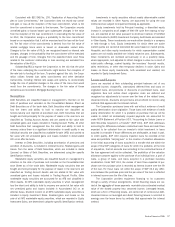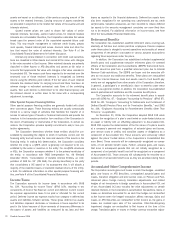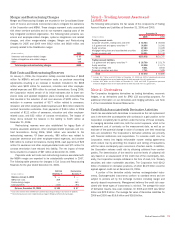Bank of America 2006 Annual Report Download - page 110
Download and view the complete annual report
Please find page 110 of the 2006 Bank of America annual report below. You can navigate through the pages in the report by either clicking on the pages listed below, or by using the keyword search tool below to find specific information within the annual report.Allowance for Credit Losses
The allowance for credit losses which includes the Allowance for Loan and
Lease Losses and the reserve for unfunded lending commitments, repre-
sents management’s estimate of probable losses inherent in the Corpo-
ration’s lending activities. The Allowance for Loan and Lease Losses
represents the estimated probable credit losses in funded consumer and
commercial loans and leases while the reserve for unfunded lending
commitments, including standby letters of credit (SBLCs) and binding
unfunded loan commitments, represents estimated probable credit losses
on these unfunded credit instruments based on utilization assumptions.
Credit exposures, excluding Derivative Assets and Trading Account Assets,
deemed to be uncollectible are charged against these accounts. Cash
recovered on previously charged off amounts are recorded as recoveries to
these accounts.
The Corporation performs periodic and systematic detailed reviews of
its lending portfolios to identify credit risks and to assess the overall col-
lectibility of those portfolios. The allowance on certain homogeneous loan
portfolios, which generally consist of consumer and certain commercial
loans such as the business card and small business portfolio, is based on
aggregated portfolio segment evaluations generally by product type. Loss
forecast models are utilized for these segments which consider a variety
of factors including, but not limited to, historical loss experience, esti-
mated defaults or foreclosures based on portfolio trends, delinquencies,
economic conditions and credit scores. These models are updated on a
quarterly basis in order to incorporate information reflective of the current
economic environment. The remaining commercial portfolios are reviewed
on an individual loan basis. Loans subject to individual reviews are ana-
lyzed and segregated by risk according to the Corporation’s internal risk
rating scale. These risk classifications, in conjunction with an analysis of
historical loss experience, current economic conditions, industry perform-
ance trends, geographic or obligor concentrations within each portfolio
segment, and any other pertinent information (including individual valu-
ations on nonperforming loans in accordance with SFAS No. 114,
“Accounting by Creditors for Impairment of a Loan,” (SFAS 114)) result in
the estimation of the allowance for credit losses. The historical loss
experience is updated quarterly to incorporate the most recent data
reflective of the current economic environment.
If necessary, a specific Allowance for Loan and Lease Losses is
established for individual impaired commercial loans. A loan is considered
impaired when, based on current information and events, it is probable
that the Corporation will be unable to collect all amounts due, including
principal and interest, according to the contractual terms of the agree-
ment. Once a loan has been identified as individually impaired, manage-
ment measures impairment in accordance with SFAS 114. Individually
impaired loans are measured based on the present value of payments
expected to be received, observable market prices, or for loans that are
solely dependent on the collateral for repayment, the estimated fair value
of the collateral. If the recorded investment in impaired loans exceeds the
present value of payments expected to be received, a specific allowance is
established as a component of the Allowance for Loan and Lease Losses.
The Allowance for Loan and Lease Losses includes two components
which are allocated to cover the estimated probable losses in each loan
and lease category based on the results of the Corporation’s detailed
review process described above. The first component covers those com-
mercial loans that are either nonperforming or impaired. The second
component covers consumer loans and leases, and performing commer-
cial loans and leases. Included within this second component of the
Allowance for Loan and Lease Losses and determined separately from the
procedures outlined above are reserves which are maintained to cover
uncertainties that affect the Corporation’s estimate of probable losses
including the imprecision inherent in the forecasting methodologies, as
well as domestic and global economic uncertainty and large single name
defaults or event risk. Management evaluates the adequacy of the Allow-
ance for Loan and Lease Losses based on the combined total of these
two components.
In addition to the Allowance for Loan and Lease Losses, the Corpo-
ration also estimates probable losses related to unfunded lending
commitments, such as letters of credit and financial guarantees, and bind-
ing unfunded loan commitments. Unfunded lending commitments are
subject to individual reviews and are analyzed and segregated by risk
according to the Corporation’s internal risk rating scale. These risk classi-
fications, in conjunction with an analysis of historical loss experience, uti-
lization assumptions, current economic conditions, performance trends
within specific portfolio segments and any other pertinent information,
result in the estimation of the reserve for unfunded lending commitments.
The allowance for credit losses related to the loan and lease portfolio
is reported on the Consolidated Balance Sheet in the Allowance for Loan
and Lease Losses. The allowance for credit losses related to the reserve
for unfunded lending commitments is reported on the Consolidated Bal-
ance Sheet in Accrued Expenses and Other Liabilities. Provision for Credit
Losses related to the loan and lease portfolio and unfunded lending
commitments is reported in the Consolidated Statement of Income in the
Provision for Credit Losses.
Nonperforming Loans and Leases, Charge-offs, and
Delinquencies
In accordance with the Corporation’s policies, non-bankrupt credit card
loans, open-end unsecured consumer loans, and real estate secured
loans are charged off no later than the end of the month in which the
account becomes 180 days past due. Personal property secured loans are
charged off no later than the end of the month in which the account
becomes 120 days past due. Accounts in bankruptcy are written down to
collateral value either 60 days after bankruptcy notification (credit card
and certain open-end unsecured accounts) or no later than the end of the
month in which the account becomes 60 days past due. Only real estate
secured accounts are generally placed into nonaccrual status and classi-
fied as nonperforming at 90 days past due. These loans can be returned
to performing status when principal or interest is less than 90 days past
due.
Commercial loans and leases, excluding business card loans, that
are past due 90 days or more as to principal or interest, or where reason-
able doubt exists as to timely collection, including loans that are
individually identified as being impaired, are generally classified as non-
performing unless well-secured and in the process of collection. Loans
whose contractual terms have been restructured in a manner which grants
a concession to a borrower experiencing financial difficulties, without
compensation on restructured loans, are classified as nonperforming until
the loan is performing for an adequate period of time under the
restructured agreement. In situations where the Corporation does not
receive adequate compensation, the restructuring is considered a troubled
debt restructuring. Interest accrued but not collected is reversed when a
commercial loan is classified as nonperforming. Interest collections on
commercial nonperforming loans and leases for which the ultimate
collectibility of principal is uncertain are applied as principal reductions;
otherwise, such collections are credited to income when received. Com-
mercial loans and leases may be restored to performing status when all
principal and interest is current and full repayment of the remaining con-
tractual principal and interest is expected, or when the loan otherwise
108
Bank of America 2006
























